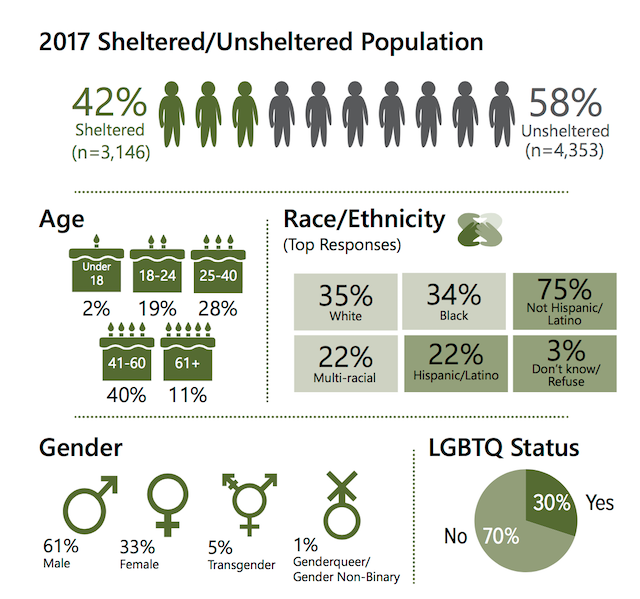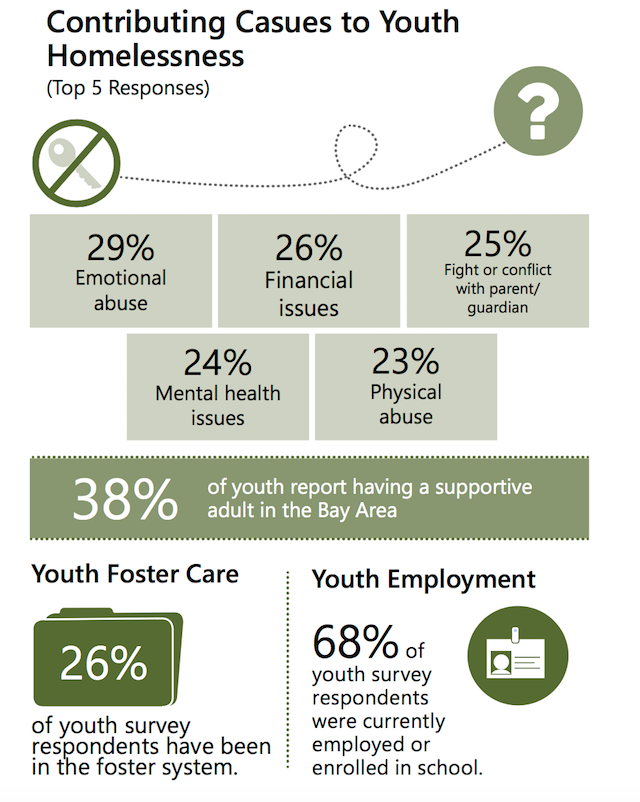Every two years since 2005, the City of San Francisco performs a "homeless census" that is officially called the "Homeless Point-In-Time Count and Survey." The 2017 results were released a couple of weeks ago and at the outset, things looked a teeny tiny bit better than they were two years prior. We told you all about that here.
This year's 78-page census results from a count one night in January 2017 revealed that overall, the homeless population decreased by 0.5%, but a closer look at the numbers as taken this past weekend by the Chronicle's Heather Knight shows that San Francisco's homeless problem is as bad as it's ever been.

While the overall drop in homelessness is half of a percent, experts think that's due to the fact that homeless families and children are being moved off the streets together. Which, good. But the number of individual homeless adults on the street, which Knight points out are the most visible members of the homeless community, have increased.
In 2016, the call line 311 received five times as many calls about homeless encampments, discarded hypodermic needles, and human waste as it did in 2015.
Here are some hard numbers.
7,499: 2017 total homeless population
7,539: 2015 total homeless population
(The number was 6,436 in 2013, and 6,455 in 2011.)
5,518: 2017 single homeless adults
5,342: 2015 single homeless adults
1,363: 2017 unaccompanied homeless youth
1,567: 2015 unaccompanied homeless youth
1,100: 2017 approximate waiting list for shelter bed
900: 2016 approximate waiting list for shelter bed
Dispelling the notion that the majority of those on our streets have drifted here from elsewhere to receive free services and food, 69% of the homeless population claim they lived in San Francisco housing prior to becoming homeless, and 55% say they've been homeless for a decade or more. 41% say that have drug or alcohol addiction, 39% claim mental health issues, and 11% say they have HIV or AIDS. As for how San Francisco's homeless population is spread throughout the city, 3,680 people live on the streets of District Six which includes much of SoMa and the Tenderloin far and away the district with the highest homeless population.

2017 City and County of San Francisco Point-in-Time Count. (image: sfgov.org)
Also, as we look at these numbers, it's important to remember exactly who is (and is not) getting counted. Claims the report:
In this study, the HUD definition of homelessness for the Point-in-Time Count is used. This definition includes individuals and families:This narrow definition of homelessness is in contrast to the considerably broader definition adopted by the City and County of San Francisco. The definition of homelessness in San Francisco expands HUD's definition to include individuals who were 'doubled-up' in the homes of family or friends, staying in jails, hospitals, and rehabilitation facilities, and families living in Single Room Occupancy (SRO) units. While this data is beyond the scope of this project, information on those residing in jails, hospitals, and rehabilitation facilities were gathered and are included in this report where applicable.
- Living in a supervised publicly or privately operated shelter designated to provide temporary living arrangement; or
- With a primary nighttime residence that is a public or private place not designed for or ordinarily used as a regular sleeping accommodation for human beings, including a car, park, abandoned building, bus or train station, airport, or camping ground.
You can pore over the whole thing with the Executive Summary, the Homeless Youth Count Report, and the Homeless Count Report. It's a lot of info.
And the Chronicle has dug into the money numbers, noting "The city spent $275 million on homelessness and supportive housing in the fiscal year that ends Friday, up from $241 million the year before. Starting Saturday, that annual spending is projected to hit an eye-popping $305 million."
The city's entire annual budget is $10 billion.
Jeff Kositsky, the director of the Department of Homelessness and Supportive Housing and whom you can read about here, is trying to stay positive in the wake of the 2017 census. Kositsky claims that since September, 11 encampments have been removed and only two of them popped back up. 70% of the people within those camps have moved indoors, thanks to outreach and services provided by the city. "Thirty percent wandered off, but that's a lot better than 100 percent. When you just go move people, that's what they do," said Kositsky.

2017 City and County of San Francisco Point-in-Time Count. (image: sfgov.org)
Kositsky, who's tasked with solving the overall homeless problem, says these things take time and money, and he's seeing improvement in the long term. Meanwhile Public Works Director Mohammed Nuru, the guy responsible for cleaning up encampments, discarded needles, and human feces, is growing impatient.
"We feel like we're a maid service. We clean, we come back. We clean, we come back. The real question is, 'Are we getting anywhere?' We don't want to just continue going around in circles," Nuru told the Chron.
According to Knight, Nuru blamed the 2016 Super Bowl (which was held in Santa Clara and celebrated endlessly in San Francisco) as a possible cause of the increase in tent encampments. At that time, certain groups were worried that the homeless would be kicked out in favor of shining San Francisco up for visitors, so many gave members of the homeless community tents.
"The Powell Street BART Station is basically a homeless shelter, and not a well-maintained one. There are homeless people sprawled all over the place, sometimes shooting up, sometimes with clothes not completely covering their backsides. Some people have seen people masturbating. There's the smell, the dirt. The needles, the human waste, the garbage. I just don't understand why we think it's OK," lamented District 8 Supervisor Jeff Sheehy.
Newest @SF_HSH navigation center coming together thanks to hard work of @sfpublicworks pic.twitter.com/aekXTbI0Hd
— Jeff Kositsky (@JeffKositsky) June 10, 2017
In his department's defense, Kositsky pointed out that when a homeless person is moved off the streets and into supportive housing, the public doesn't really notice it. "Our successes are invisible, and our failures to resolve a problem are very evident," he explained.
As for Neru, he echoed a sentiment that many newcomers and tourists have said about SF in recent years, speaking to the Chron: "It just hurts me to see a beautiful city like this."
Related: There Are Close To 1,500 Homeless Youth Living On San Francisco Streets
2017 City and County of San Francisco Point-in-Time Count. (image: sfgov.org)
